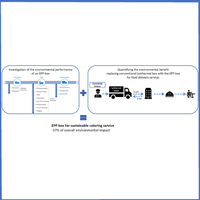 Smart Citations
Smart CitationsSee how this article has been cited at scite.ai
scite shows how a scientific paper has been cited by providing the context of the citation, a classification describing whether it supports, mentions, or contrasts the cited claim, and a label indicating in which section the citation was made.
Assessment of an expanded-polypropylene isothermal box to improve logistic sustainability of catering services
The European catering sector is hugely expanding and serves over 6 billion meals every year, which translate in 65 million meals per day. The aim of our study was to investigate the environmental performance of the expanded-polypropylene (EPP) box production process to improve sustainability in catering services. Moreover, a quantification of the environmental benefit in using the EPP box instead of the conventional packaging was performed. The life cycle assessment was conducted following the ISO 14044:2006 standard. The EPP box for food delivery makes it possible to design a catering service characterised by –37% of overall impacts compared to the use of the common box. EPP represents a useful solution for environmentally sustainable catering services due to its mechanical response and the insulating properties of the polymer foam. The environmental impact of the EPP box life cycle can be further reduced (–29%) by changing the energy country mix and applying a circular economy model, thus recycling the 100% of the EPP box. In conclusion, the EPP box represents a useful solution for an environmentally sustainable catering service.
How to Cite

This work is licensed under a Creative Commons Attribution-NonCommercial 4.0 International License.
PAGEPress has chosen to apply the Creative Commons Attribution NonCommercial 4.0 International License (CC BY-NC 4.0) to all manuscripts to be published.

 https://doi.org/10.4081/jae.2021.1139
https://doi.org/10.4081/jae.2021.1139




